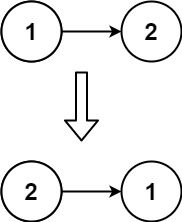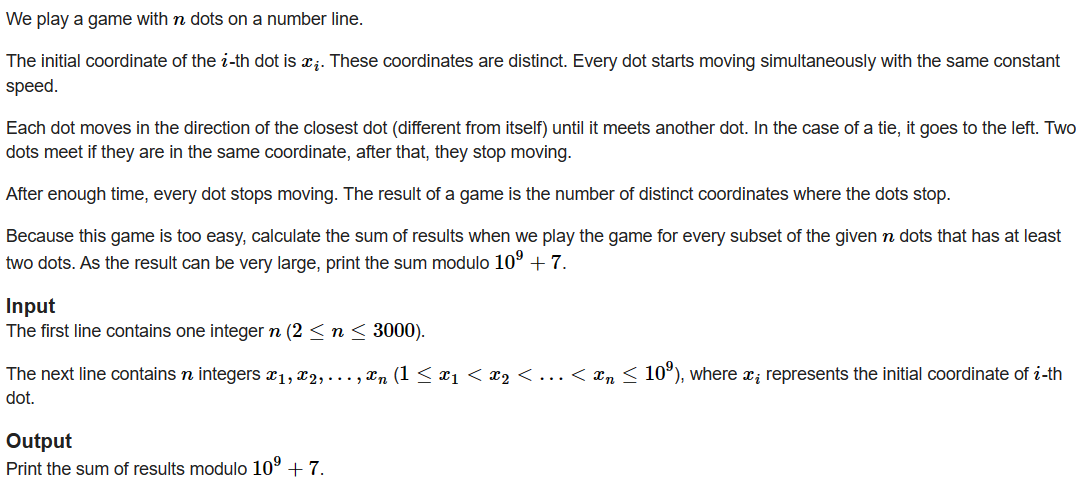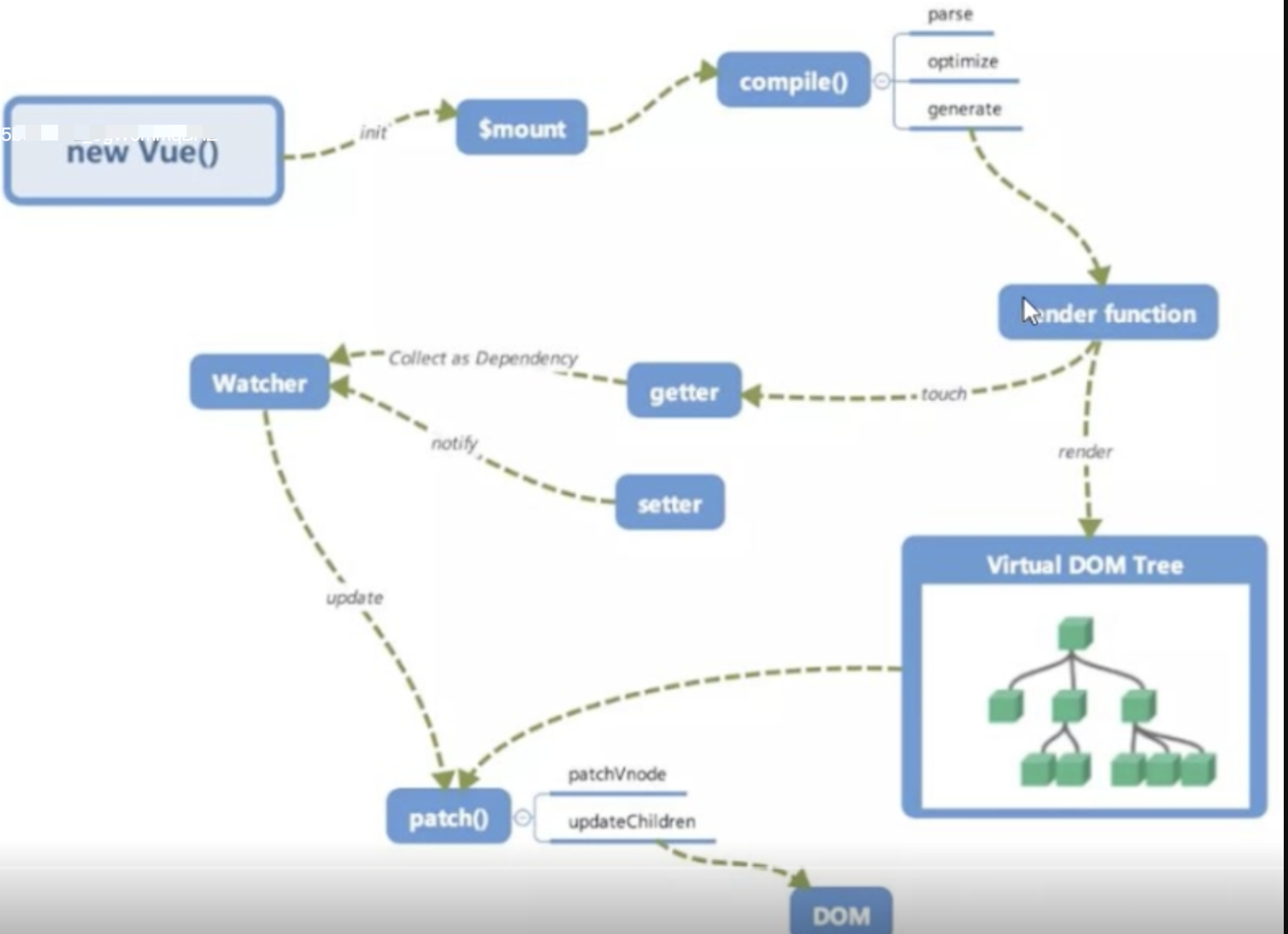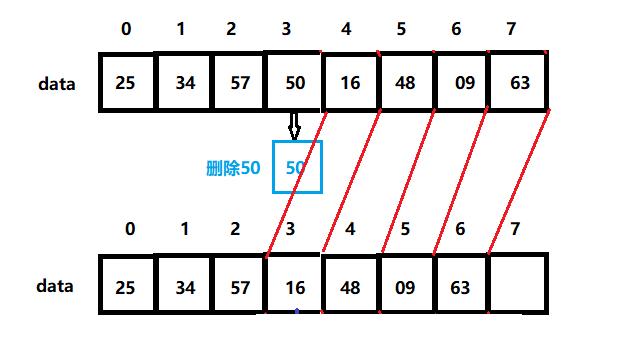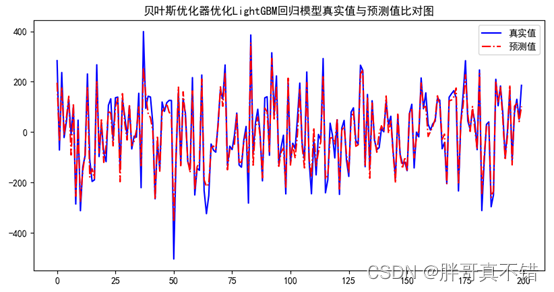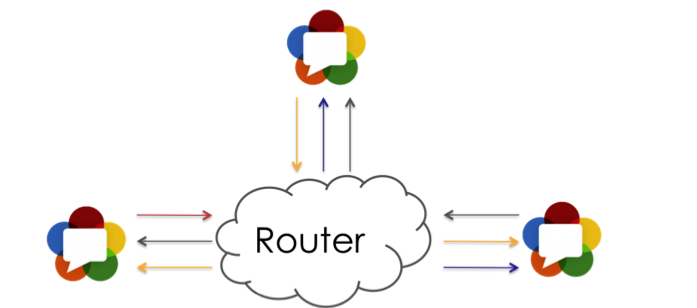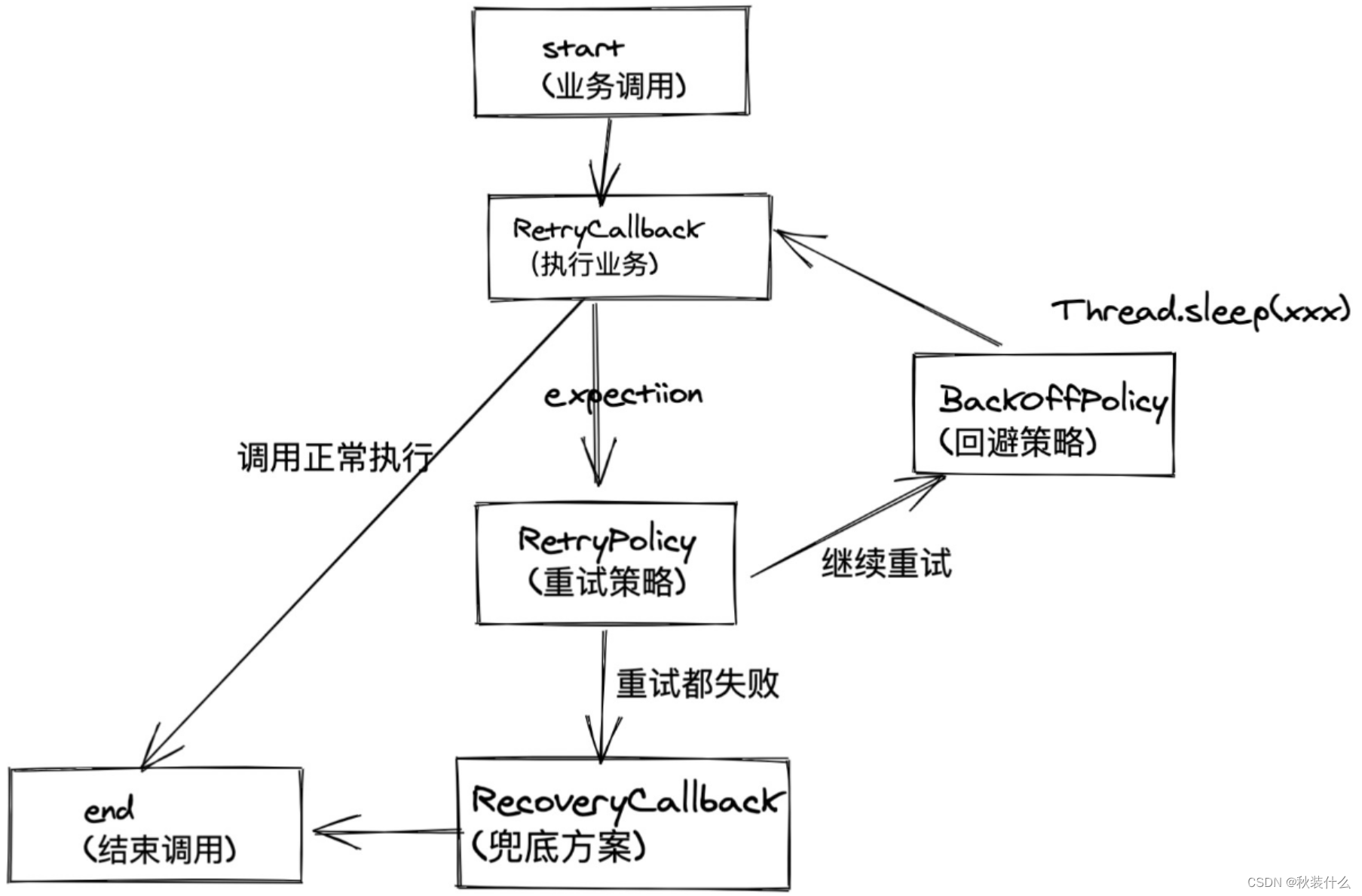博客系统url : 链接
项目已上传gitee : 链接
前言
之前笔者已经使用Servlet结合MySQL实现了第一版的个人博客。在这一版的博客系统中,将进行以下功能的升级:
- 框架升级:SSM版本,即(Spring + SpringMVC + MyBatis) ,结合MySQL、Redis以及JQuery。
- 密码升级:明文存储/md5存储—>加盐处理。
- 用户登录状态持久化升级:将session持久化到Redis/MySQL。
- 功能升级:实现分页功能。
- 使用拦截器升级用户登录验证。
一:新建项目
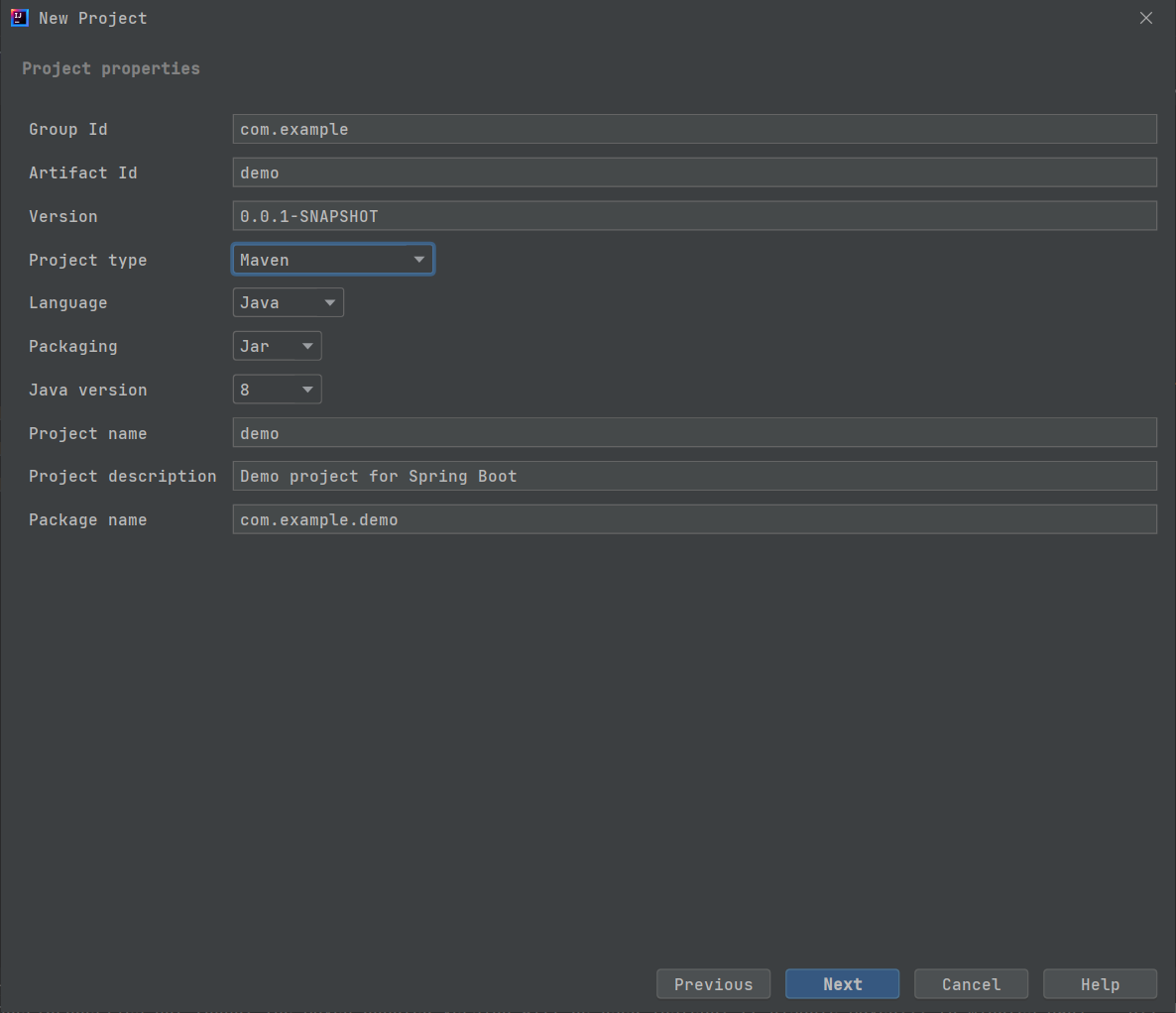
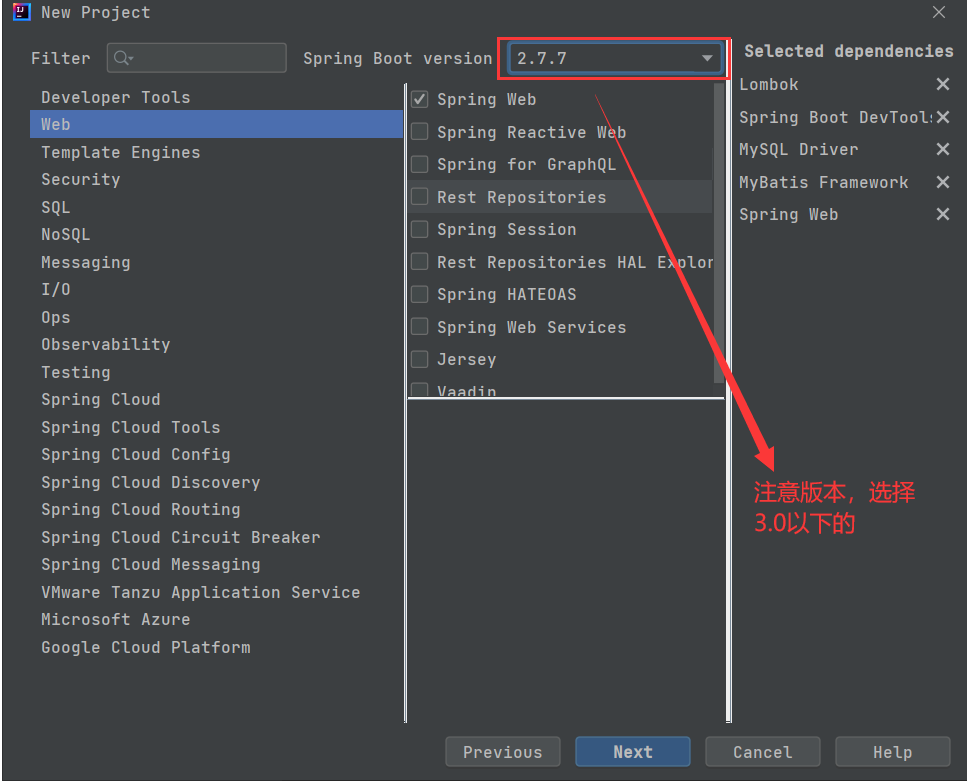
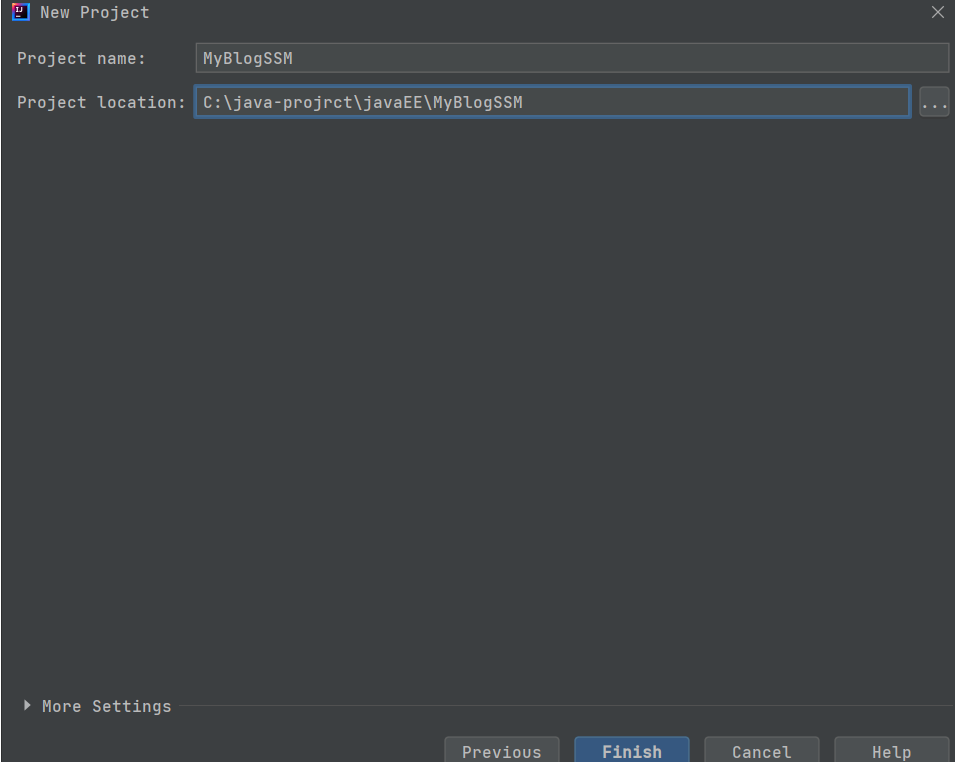
配置applicaiton.yml文件:
# 配置数据库的连接字符串
spring:
datasource:
url: jdbc:mysql://127.0.0.1/myblog?characterEncoding=utf8
username: root
password: 111111
driver-class-name: com.mysql.cj.jdbc.Driver
# 设置 Mybatis 的 xml 保存路径
mybatis:
mapper-locations: classpath:mapper/**Mapper.xml
configuration: # 配置打印 MyBatis 执行的 SQL
log-impl: org.apache.ibatis.logging.stdout.StdOutImpl
# 配置打印 MyBatis 执行的 SQL
logging:
level:
com:
example:
demo: debug
二:搭建项目框架
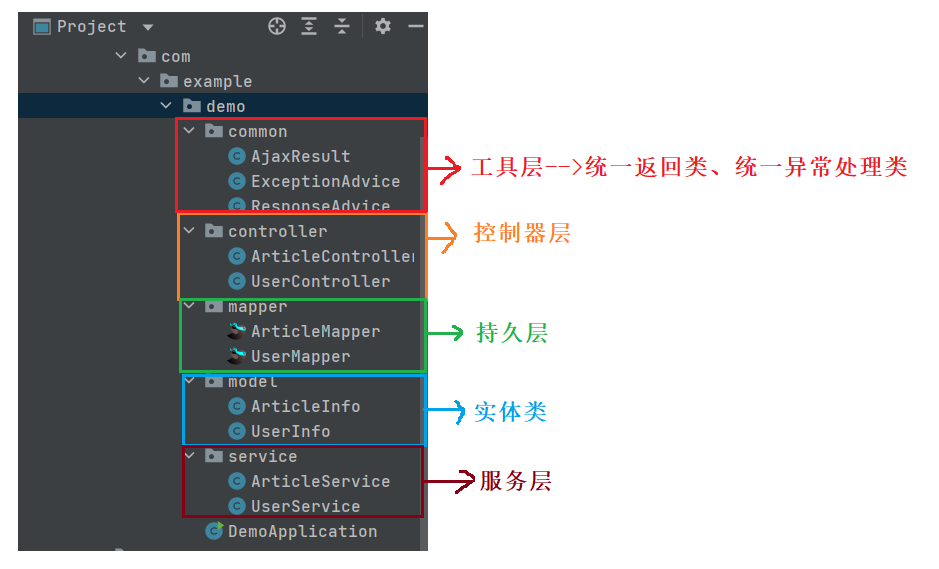
三:引入前端的页面
前端页面和上一版博客系统差别不大,此处直接引入即可。
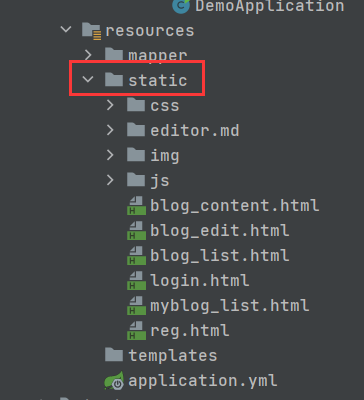
置于static目录下即可。
四:实现前后端交互功能
4.1 统一数据格式返回

AjaxResult
package com.example.demo.common;
import java.util.HashMap;
/**
* 自定义的统一返回对象
*/
public class AjaxResult {
/**
* 业务执行成功时进行返回的方法
* @param data
* @return
*/
public static HashMap<String,Object> success(Object data) {
HashMap<String,Object> result = new HashMap<>();
result.put("code",200);
result.put("msg","");
result.put("data",data);
return result;
}
public static HashMap<String,Object> success(String msg, Object data) {
HashMap<String,Object> result = new HashMap<>();
result.put("code",200);
result.put("msg",msg);
result.put("data",data);
return result;
}
/**
* 业务执行失败时进行返回的方法
* @param code
* @param msg
* @return
*/
public static HashMap<String,Object> fail(String msg,int code) {
HashMap<String,Object> result = new HashMap<>();
result.put("code",code);
result.put("msg",msg);
result.put("data","");
return result;
}
}
ExceptionAdvice
package com.example.demo.common;
import org.springframework.web.bind.annotation.ControllerAdvice;
import org.springframework.web.bind.annotation.ExceptionHandler;
import org.springframework.web.bind.annotation.ResponseBody;
/**
* 异常类的统一处理
*/
@ControllerAdvice // 控制器通知类
@ResponseBody
public class ExceptionAdvice {
@ExceptionHandler(Exception.class) // 异常处理器
public Object exceptionAdvice(Exception e) {
return AjaxResult.fail(e.getMessage(),-1);
}
}
ResponseAdvice
package com.example.demo.common;
import com.fasterxml.jackson.core.JsonProcessingException;
import com.fasterxml.jackson.databind.ObjectMapper;
import org.springframework.core.MethodParameter;
import org.springframework.http.MediaType;
import org.springframework.http.server.ServerHttpRequest;
import org.springframework.http.server.ServerHttpResponse;
import org.springframework.web.bind.annotation.ControllerAdvice;
import org.springframework.web.servlet.mvc.method.annotation.ResponseBodyAdvice;
import java.util.HashMap;
/**
* 统一数据返回封装
*/
@ControllerAdvice
public class ResponseAdvice implements ResponseBodyAdvice {
@Override
public boolean supports(MethodParameter returnType, Class converterType) {
return true;
}
@Override
public Object beforeBodyWrite(Object body, MethodParameter returnType, MediaType selectedContentType, Class selectedConverterType, ServerHttpRequest request, ServerHttpResponse response) {
if(body instanceof HashMap) {// 已经是封装好的对象
return body;
}
if(body instanceof String) {// 返回对象是String类型(特殊)
ObjectMapper objectMapper = new ObjectMapper();
try {
return objectMapper.writeValueAsString(AjaxResult.success(body));
} catch (JsonProcessingException e) {
e.printStackTrace();
}
}
return AjaxResult.success(body);
}
}
4.2 注册功能
注册前端页面如下:
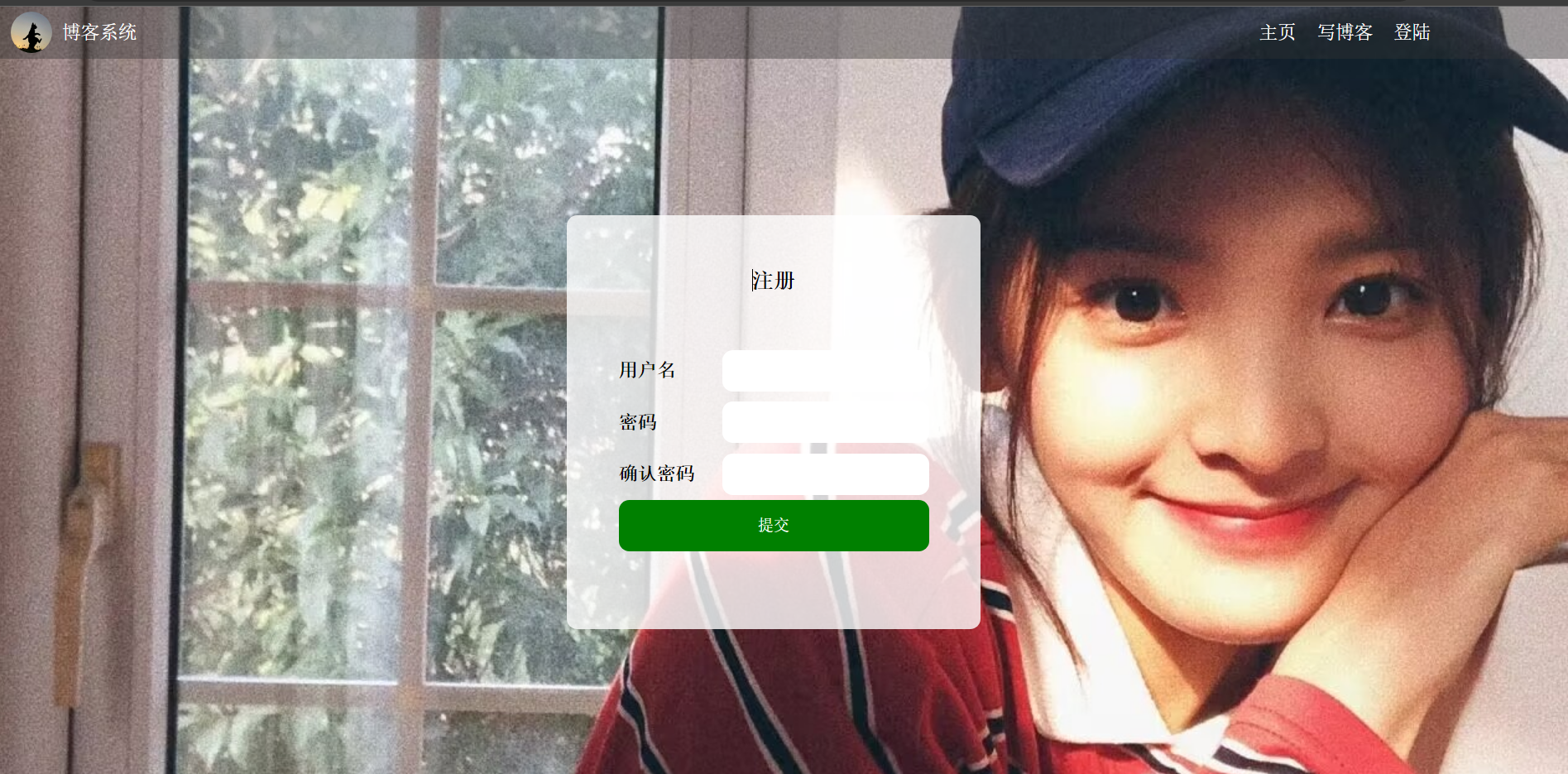
<!DOCTYPE html>
<html lang="en">
<head>
<meta charset="UTF-8">
<meta http-equiv="X-UA-Compatible" content="IE=edge">
<meta name="viewport" content="width=device-width, initial-scale=1.0">
<title>注册页面</title>
<link rel="stylesheet" href="css/conmmon.css">
<link rel="stylesheet" href="css/login.css">
</head>
<body>
<!-- 导航栏 -->
<div class="nav">
<img src="img/logo2.jpg" alt="">
<span class="title">我的博客系统</span>
<!-- 用来占据中间位置 -->
<span class="spacer"></span>
<a href="blog_list.html">主页</a>
<a href="blog_edit.html">写博客</a>
<a href="login.html">登录</a>
<!-- <a href="#">注销</a> -->
</div>
<!-- 版心 -->
<div class="login-container">
<!-- 中间的注册框 -->
<div class="login-dialog">
<h3>注册</h3>
<div class="row">
<span>用户名</span>
<input type="text" id="username">
</div>
<div class="row">
<span>密码</span>
<input type="password" id="password">
</div>
<div class="row">
<span>确认密码</span>
<input type="password" id="password2">
</div>
<div class="row">
<button id="submit">提交</button>
</div>
</div>
</div>
</body>
</html>
Step1:引入jQuery
jQuery教程
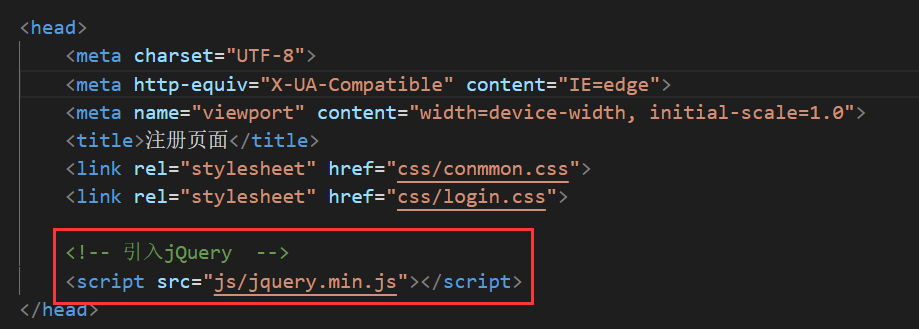
Step2:编写前端代码
<button id="submit" onclick="mysub()">提交</button>
<script>
function mysub() {
//1.非空校验
var username = jQuery("#username");
var password = jQuery("#password");
var password2 = jQuery("#password2");
if(username.val() == "") {
alert("请输入用户名!");
username.focus(); // 将光标移动到username的输入框处
return false;
}
if(password.val() == "") {
alert("请输入密码!");
password.focus(); // 将光标移动到password的输入框处
return false;
}
if(password2.val() == "") {
alert("请再次确认密码!");
password2.focus(); // 将光标移动到password2的输入框处
return false;
}
if(password.val() != password2.val()) {
alert("两次密码输入不一致,请重新输入!");
password.focus();
return false;
}
//2.发送ajax请求给后端
jQuery.ajax({
url:"/user/reg",
type:"POST",
data:{
username:username.val(),
password:password.val()
},
success:function(result) {
if(result.code == 200 && result.data == 1) {
alert("恭喜你,注册成功!");
if(confirm("是否转到登录页?")) {
location.href = "login.html";
}
}else {
alert("注册失败,请稍后再试!");
}
}
});
}
</script>
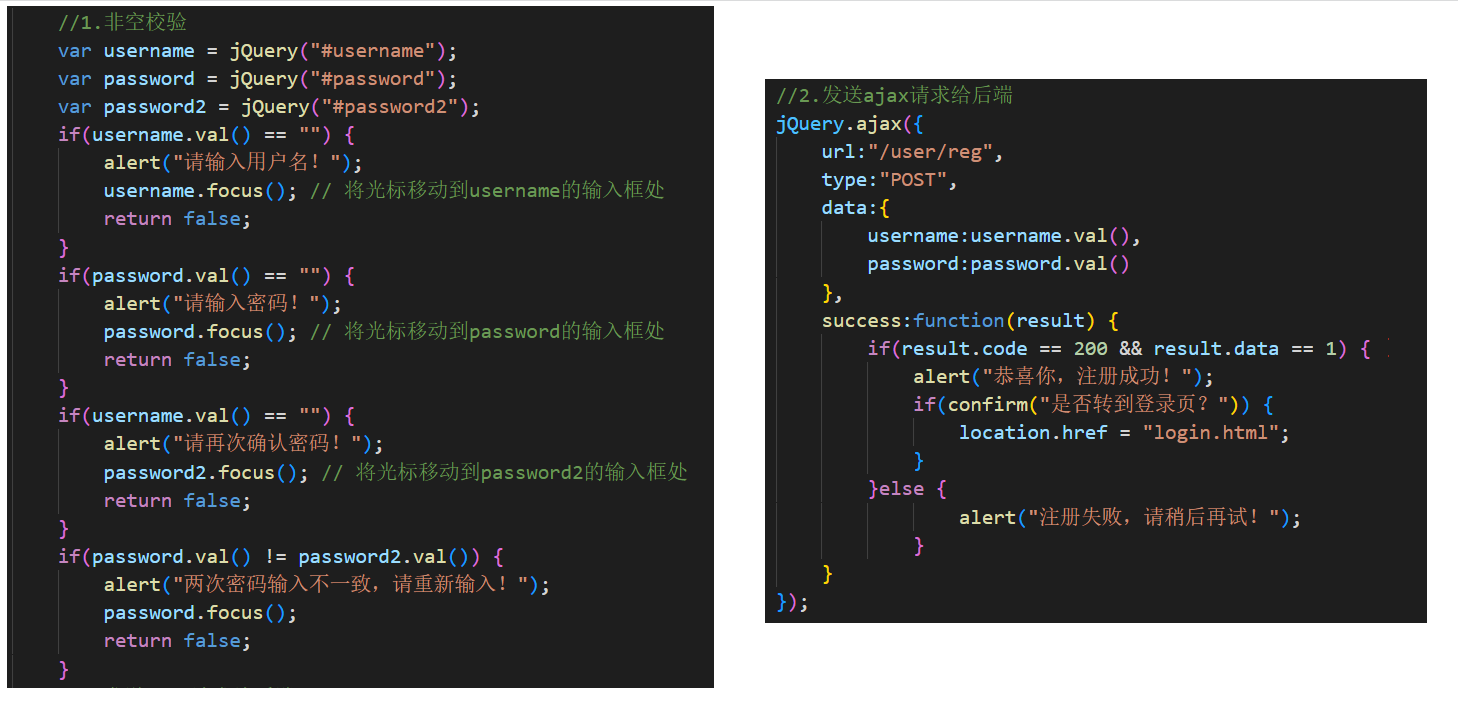
Step3:编写后端代码
UserController
package com.example.demo.controller;
import com.example.demo.common.AjaxResult;
import com.example.demo.service.UserService;
import org.springframework.beans.factory.annotation.Autowired;
import org.springframework.util.StringUtils;
import org.springframework.web.bind.annotation.RequestMapping;
import org.springframework.web.bind.annotation.RestController;
/**
* 用户控制器
*/
@RestController// 返回页面不是数据
@RequestMapping("/user")
public class UserController {
@Autowired
private UserService userService;
@RequestMapping("/reg")
public Object reg(String username,String password) {
//1.非空校验
if(!StringUtils.hasLength(username) || !StringUtils.hasLength(password)) {
return AjaxResult.fail(-1,"非法的参数请求");
}
//2.进行添加操作
int result = userService.add(username,password);
if(result == 1) {
return AjaxResult.success("添加成功!",1);
} else {
return AjaxResult.fail("数据库添加出错!",-1);
}
}
}
UserService
package com.example.demo.service;
import com.example.demo.mapper.UserMapper;
import org.springframework.beans.factory.annotation.Autowired;
import org.springframework.stereotype.Service;
/**
* 用户表服务层
*/
@Service
public class UserService {
@Autowired
private UserMapper userMapper;
public int add(String username,String password) {
return userMapper.add(username,password);
}
}
UserMapper
package com.example.demo.mapper;
import org.apache.ibatis.annotations.Mapper;
import org.apache.ibatis.annotations.Param;
/**
* 用户表mapper
*/
@Mapper
public interface UserMapper {
public int add(@Param("username") String username,
@Param("password") String password);
}
UserMapper.xml
<?xml version="1.0" encoding="UTF-8"?>
<!DOCTYPE mapper PUBLIC "-//mybatis.org//DTD Mapper 3.0//EN" "http://mybatis.org/dtd/mybatis-3-mapper.dtd">
<mapper namespace="com.example.demo.mapper.UserMapper">
<insert id = "add">
insert into userinfo(username,password)
values(#{username},#{password})
</insert>
</mapper>
查看数据库中的数据:

进行添加操作:
点击提交:
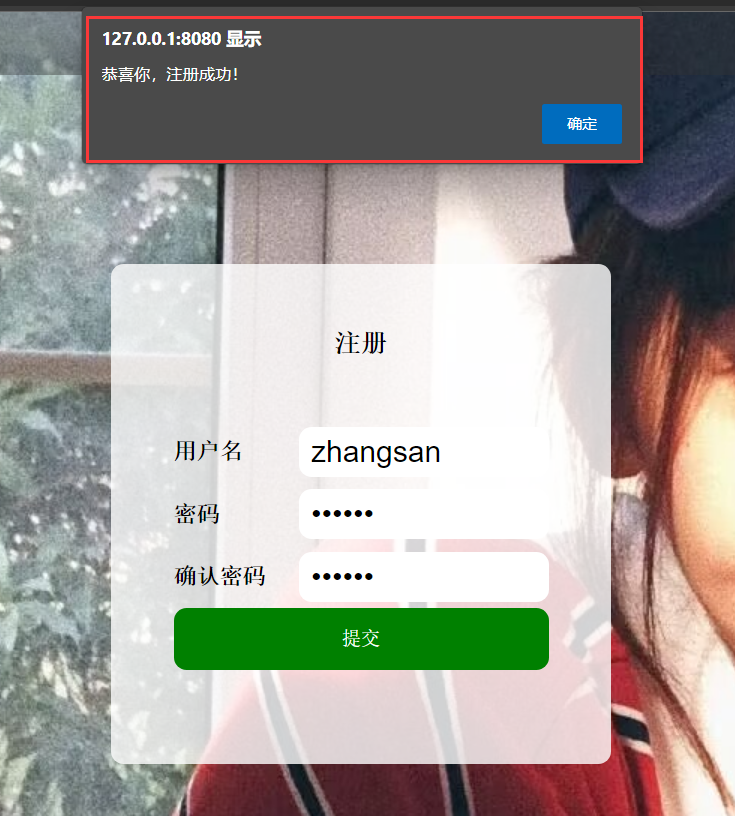
点击确认:

点击确认:

转到登录页。
4.3 登录功能
登录前端页面如下:

<!DOCTYPE html>
<html lang="en">
<head>
<meta charset="UTF-8">
<meta http-equiv="X-UA-Compatible" content="IE=edge">
<meta name="viewport" content="width=device-width, initial-scale=1.0">
<title>登陆页面</title>
<link rel="stylesheet" href="css/conmmon.css">
<link rel="stylesheet" href="css/login.css">
</head>
<body>
<!-- 导航栏 -->
<div class="nav">
<img src="img/logo2.jpg" alt="">
<span class="title">博客系统</span>
<!-- 用来占据中间位置 -->
<span class="spacer"></span>
<a href="blog_list.html">主页</a>
<a href="blog_edit.html">写博客</a>
<a href="login.html">登录</a>
<!-- <a href="#">注销</a> -->
</div>
<!-- 版心 -->
<div class="login-container">
<!-- 中间的登陆框 -->
<div class="login-dialog">
<h3>登陆</h3>
<div class="row">
<span>用户名</span>
<input type="text" id="username">
</div>
<div class="row">
<span>密码</span>
<input type="password" id="password">
</div>
<div class="row">
<button id="submit">提交</button>
</div>
</div>
</div>
</body>
</html>
Step1:引入jQuery
<script src="js/jquery.min.js"></script>
Step2:编写前端代码
<button id="submit" onclick="mysub()">提交</button>
<script>
function mysub(){
// 1.先进行非空效验
var username = jQuery("#username");
var password = jQuery("#password");
if(username.val()==""){
alert("请先输入用户名!");
username.focus();
return false;
}
if(password.val()==""){
alert("请先输入密码!");
password.focus();
return false;
}
// 2.发送请求给后端
jQuery.ajax({
url:"/user/login",
type:"POST",
data:{
"username":username.val(),
"password":password.val()
},
success:function(result){
if(result.code==200 && result.data==1){
alert("登录成功!");
location.href = "myblog_list.html";
}else{
alert("用户名或密码错误,请重新输入!");
username.focus();
}
}
});
}
</script>
Step3:编写后端代码
UserController
@RequestMapping("/login")
public int login(HttpServletRequest request, String username, String password) {
// 1.非空效验
if (!StringUtils.hasLength(username) || !StringUtils.hasLength(password)) {
return 0;
}
// 2. 进行查询操作
UserInfo userInfo = userService.login(username, password);
if (userInfo == null || userInfo.getId() <= 0) {
// 用户名或密码错误,userInfo无效
return -1;
} else {
//用户名和密码正确,将userInfo保存到session中
HttpSession session = request.getSession();
session.setAttribute(Constant.SESSION_USERINFO_KEY, userInfo);
return 1;
}
}
UserService
public UserInfo login(String username, String password) {
return userMapper.login(username, password);
}
UserMapper
public UserInfo login(@Param("username") String username,
@Param("password") String password);
UserMapper.xml
<select id="login" resultType="com.example.demo.model.UserInfo">
select * from userinfo where
username=#{username} and password=#{password}
</select>
进行登录操作:
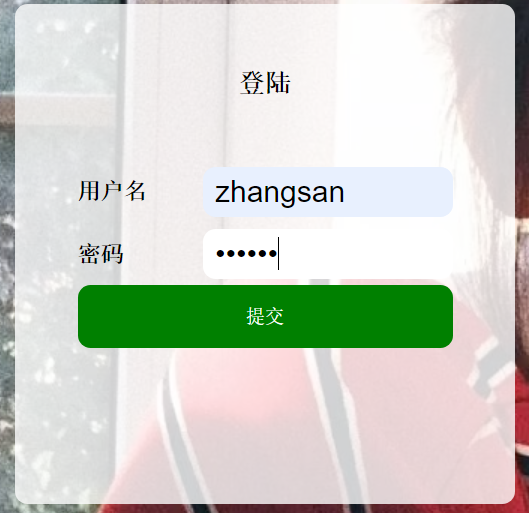

点击确认,跳转到列表详情页。

4.4 统一用户登录权限验证
1.创建自定义拦截器,实现 HandlerInterceptor 接口的 preHandle(执行具体方法之前的预处理)⽅法。
LoginInterceptor
package com.example.demo.common;
import org.springframework.stereotype.Component;
import org.springframework.web.servlet.HandlerInterceptor;
import javax.servlet.http.HttpServletRequest;
import javax.servlet.http.HttpServletResponse;
import javax.servlet.http.HttpSession;
@Component
public class LoginInterceptor implements HandlerInterceptor {
@Override
public boolean preHandle(HttpServletRequest request, HttpServletResponse response, Object handler) throws Exception {
HttpSession session = request.getSession(false);
if(session != null && session.getAttribute(Constant.SESSION_USERINFO_KEY) != null) {
// 当前用户已登录
return true;
}
response.setStatus(401);// 未登录
return false;
}
}
Q : 为什么session中的key值都一样 , 却能够区分不同的登录用户身份呢 ?
A :

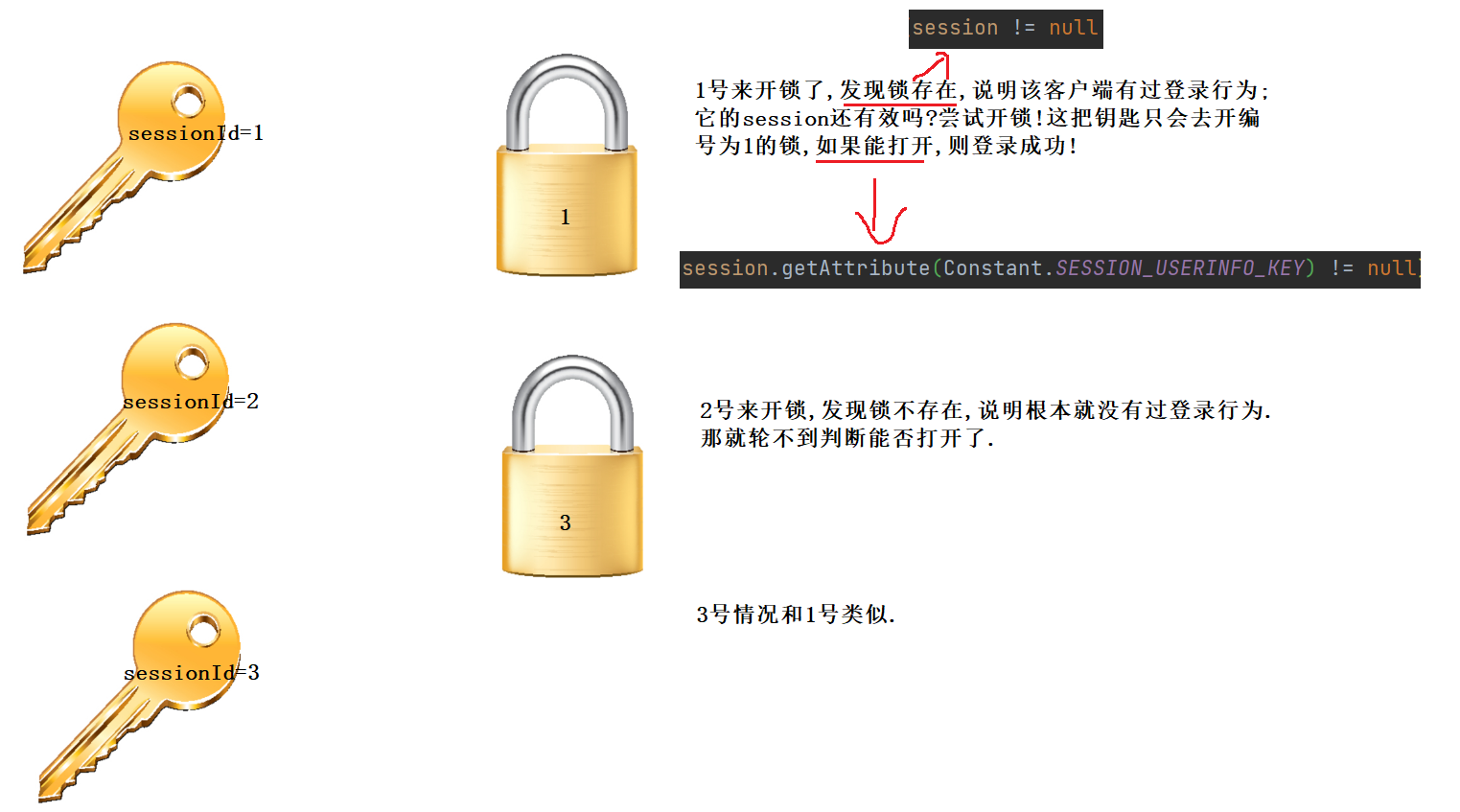

session!=null意味着sessionId不为空 , 而sessionId不为空 , 只能说明该客户端有过登录行为 , 而其session是否还有效 , 就要根据session.getAttribute()!=null来判断了.
2.将自定义拦截器加入 WebMvcConfigurer 的 addInterceptors 方法中。
package com.example.demo.common;
import org.springframework.beans.factory.annotation.Autowired;
import org.springframework.context.annotation.Configuration;
import org.springframework.web.servlet.config.annotation.InterceptorRegistration;
import org.springframework.web.servlet.config.annotation.InterceptorRegistry;
import org.springframework.web.servlet.config.annotation.WebMvcConfigurer;
import java.util.ArrayList;
import java.util.List;
/**
* 自定义拦截规则
*/
@Configuration
public class AppConfig implements WebMvcConfigurer {
//不拦截的url集合
List<String> excludes = new ArrayList<String>(){{
add("/js/**");// "/js/**"表示放行js路径下的所有文件
add("/editor.md/**");
add("/css/**");
add("/img/**");
add("/user/login");// 放行登录接口
add("/user/reg");// 放行注册接口
add("/art/setrcount");// 放行访问量设置接口
add("/art/list");// 放行文章分页列表
add("/art/totalpage");// 放行总页面数接口
add("/login.html");
add("/blog_list.html");
add("/myblog_list.html");
add("/reg.html");
}
};
@Autowired
private LoginInterceptor loginInterceptor;// 导入拦截器
@Override
public void addInterceptors(InterceptorRegistry registry) {
//配置拦截器
InterceptorRegistration registration =
registry.addInterceptor(loginInterceptor);
registration.addPathPatterns("/**");
registration.excludePathPatterns(excludes);
}
}
4.5 列表页
列表页前端页面如下 :

<!DOCTYPE html>
<html lang="en">
<head>
<meta charset="UTF-8">
<meta http-equiv="X-UA-Compatible" content="IE=edge">
<meta name="viewport" content="width=device-width, initial-scale=1.0">
<title>博客列表</title>
<link rel="stylesheet" href="css/conmmon.css">
<link rel="stylesheet" href="css/blog_list.css">
<script src="js/jquery.min.js"></script>
</head>
<body>
<!-- 导航栏 -->
<div class="nav">
<img src="img/logo2.jpg" alt="">
<span class="title">博客系统</span>
<!-- 用来占据中间位置 -->
<span class="spacer"></span>
<a href="blog_list.html">主页</a>
<a href="blog_edit.html">写博客</a>
<a href="javascript:onExit()">注销</a>
</div>
<!-- 版心 -->
<div class="container">
<!-- 左侧个人信息 -->
<div class="container-left" >
<div class="card">
<img src="img/touxiang.jpg" class="avtar" alt="">
<h3 id="username"></h3>
<a href="https://gitee.com/">gitee 地址</a>
<div class="counter">
<span>文章</span>
<span>访问量</span>
</div>
<div class="counter">
<span id="articleCount">0</span>
<span id="totalRcount">0</span>
</div>
</div>
</div>
<!-- 右侧内容详情 -->
<div class="container-right" id="artlistDiv">
</div>
</div>
</body>
</html>
Step1.引入jQuery
<script src="js/jquery.min.js"></script>
Step2:编写前后端代码
4.5.1 注销功能
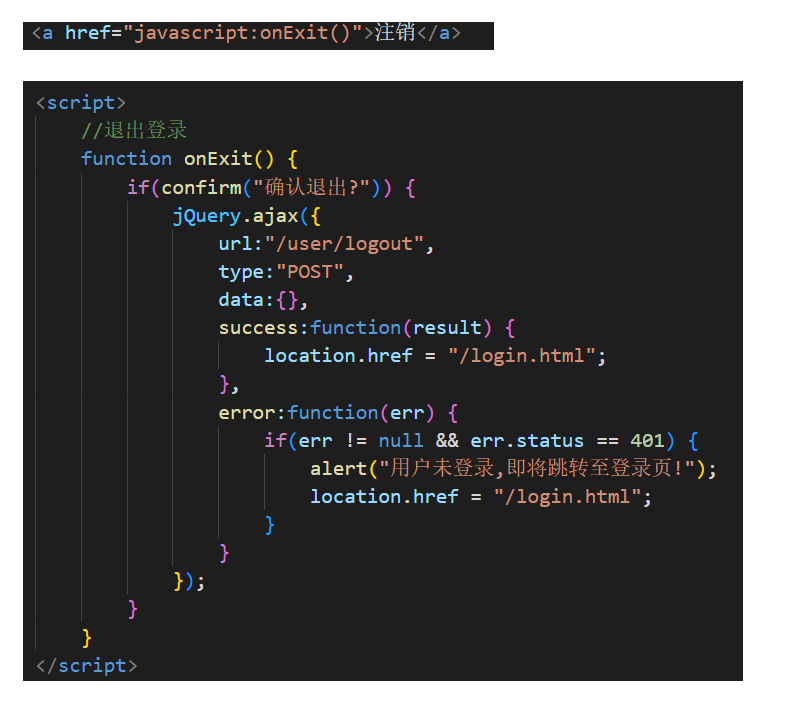
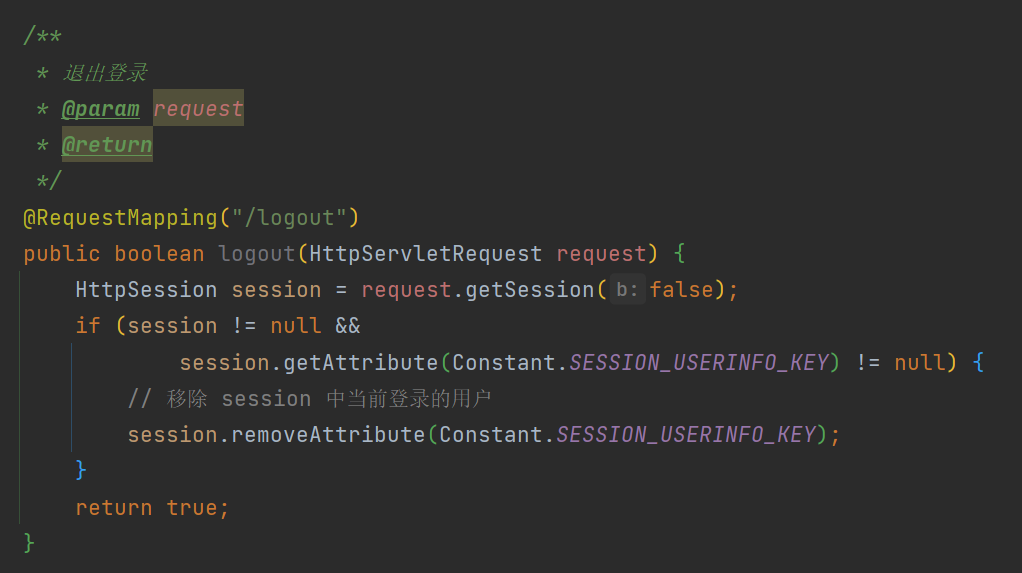
4.5.2 显示所有文章
显示文章 , 只需将原来页面中的文章div用数据库中查询出的数据进行替换即可 . 实现步骤如下 :
myblog_list.html
var descLength = 80; // 简介最大长度
// 字符串截取,将文章正文截取成简介
function mySubstr(content){
if(content.length>descLength){
return content.substr(0,descLength);
}
return content;
}
// 初始化个人列表信息
function initList(){
jQuery.ajax({
url:"/art/mylist",
type:"POST",
data:{},
success:function(result){
getArticleCount(result.data[0].uid); //获取文章数
getTotalRcount(result.data[0].uid); //获取访问量
if(result.code==200 && result.data!=null
&& result.data.length>0){
// 此人发表文章了
var html="";
result.data.forEach(function(item){
html+='<div class="blog">';
html+='<div class="title">'+item.title+'</div>';
html+='<div class="date">'+item.createtime+'</div>'
html+='<div class="desc">'+mySubstr(item.content)+' </div>';
html+='<div style="text-align: center;margin-top: 50px;">';
html+='<a id="clickIt" href="blog_content.html?id='+item.id+'">查看详情</a> ';
html+='<a id="clickIt" href="blog_update.html?id='+item.id+'">修改</a> '
html+='<a id="clickIt" href="javascript:myDel('+item.id+')">删除</a></div>' +'</div>';
});
jQuery("#artlistDiv").html(html);
}else{
// 此人未发表任何文章
jQuery("#artlistDiv").html("<h1>暂无数据</h1>");
}
},
error:function(err){
if(err!=null && err.status==401){
alert("用户未登录,即将跳转到登录页!");
// 已经被拦截器拦截了,未登录
location.href = "/login.html";
}
}
});
}
initList(); // 当浏览器渲染引擎执行到此行的时候就会调用 initList() 方法
后端部分 :
ArticleController
/**
* 返回文章信息
* @param request
* @return
*/
@RequestMapping("mylist")
public List<ArticleInfo> myList(HttpServletRequest request) {
UserInfo userInfo = SessionUtil.getLoginUser(request);
if(userInfo != null) {
return articleService.getMyList(userInfo.getId());
}
return null;
}
SessionUtil
package com.example.demo.common;
import com.example.demo.model.UserInfo;
import javax.servlet.http.HttpServletRequest;
import javax.servlet.http.HttpSession;
public class SessionUtil {
/**
* 查询当前登录用户的session
* @param request
* @return
*/
public static UserInfo getLoginUser(HttpServletRequest request) {
HttpSession session = request.getSession(false);
if (session != null &&
session.getAttribute(Constant.SESSION_USERINFO_KEY) != null) {
return (UserInfo) session.getAttribute(Constant.SESSION_USERINFO_KEY);
}
return null;
}
}
ArticleService
package com.example.demo.service;
import com.example.demo.mapper.ArticleMapper;
import com.example.demo.model.ArticleInfo;
import org.springframework.beans.factory.annotation.Autowired;
import org.springframework.stereotype.Service;
import java.util.List;
/**
*文章表服务层
*/
@Service
public class ArticleService {
@Autowired
private ArticleMapper articleMapper;
public List<ArticleInfo> getMyList(Integer uid) {
return articleMapper.getMyList(uid);
}
}
ArticleMapper
package com.example.demo.mapper;
import com.example.demo.model.ArticleInfo;
import org.apache.ibatis.annotations.Mapper;
import org.apache.ibatis.annotations.Param;
import java.util.List;
/**
* 文章表mapper
*/
@Mapper
public interface ArticleMapper {
public List<ArticleInfo> getMyList(@Param("uid") Integer uid);
}
ArticleMapper.xml
<select id="getMyList" resultType="com.example.demo.model.ArticleInfo">
select * from articleinfo where uid=#{uid}
</select>
运行结果 :
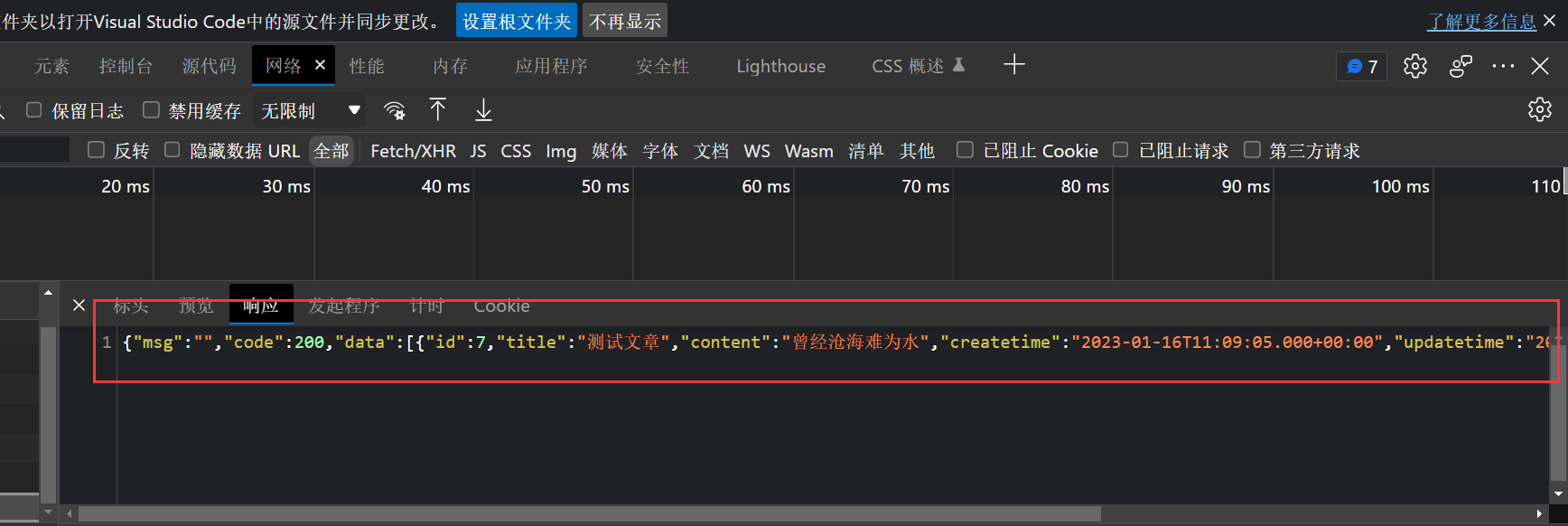
因为进行了统一的数据格式返回封装 , 所以返回的格式非常清晰 , 当状态码code为200时 , 证明后端成功查询并返回了数据 , 此时前端需要做的 , 就是将后端返回的数据显示在页面上 .
在获取全部文章并显示在页面上同时 , 需要将该作者的文章数和访问量获取到 , 并显示在个人信息栏 . 其代码分别如下 :
前端代码 :
//获取文章数
function getArticleCount(uid) {
var articleCount = 0;
jQuery.ajax({
url:"/art/getarticlecount",
type:"POST",
data:{"uid":uid},
success:function(result) {
if(result.code == 200 && result.data != null) {
jQuery("#articleCount").text(result.data);
}
},
error:function(err) {
}
});
}
//获取作者总访问量
function getTotalRcount(uid) {
jQuery.ajax({
url:"/art/gettotalrcount",
type:"POST",
data:{"uid":uid},
success:function(result) {
jQuery("#totalRcount").text(result.data);
}
});
}
后端代码 :
ArticleController
/**
* 获取总访问量
* @return
*/
@RequestMapping("/gettotalrcount")
public Integer getTotalRcount(Integer uid) {
return articleService.getTotalRcount(uid);
}
/**
* 获取文章数
* @param uid
* @return
*/
@RequestMapping("/getarticlecount")
public Integer getArticleCount(Integer uid) {
return articleService.getArticleCount(uid);
}
ArticleService
/**
* 获取总访问量
* @return
*/
public Integer getTotalRcount(Integer uid) {
return articleMapper.getTotalRcount(uid);
}
/**
* 获取文章数
* @param id
* @return
*/
public Integer getArticleCount(Integer id) {
return articleMapper.getArticleCount(id);
}
ArticleMapper
//获取当前登录用户文章数
public Integer getArticleCount(@Param("uid") Integer uid);
//获取总访问量
public Integer getTotalRcount(@Param("uid") Integer uid);
ArticleMapper.xml
<!-- 获取当前登录用户文章数-->
<select id="getArticleCount" resultType="java.lang.Integer">
select count(*) from articleinfo where uid=#{uid}
</select>
<!-- 获取总访问量-->
<select id="getTotalRcount" resultType="java.lang.Integer">
select sum(rcount) from articleinfo where uid=#{uid};
</select>
4.5.3 初始化侧边栏
在第二步中 , 已经获取到了当前用户的文章数和访问量 , 只需获取到用户名并加载到页面上即可 .
前端代码 :
// 获取个人信息
function myInfo(){
jQuery.ajax({
url:"/user/myinfo",
type:"POST",
data:{},
success:function(result){
if(result.code==200 && result.data!=null){
jQuery("#username").text(result.data.username);
}
},
error:function(err){
}
});
}
myInfo();
后端代码 :
UserController
/**
* 获取当前登录用户列表页
* @param request
* @return
*/
@RequestMapping("/myinfo")
public UserInfo myInfo(HttpServletRequest request) {
HttpSession session = request.getSession(false);
if (session != null &&
session.getAttribute(Constant.SESSION_USERINFO_KEY) != null) {
return (UserInfo) session.getAttribute(Constant.SESSION_USERINFO_KEY);
}
return null;
}
4.5.4 编辑页
点击写博客 , 跳转至博客编辑页 , 编写编辑页代码 .
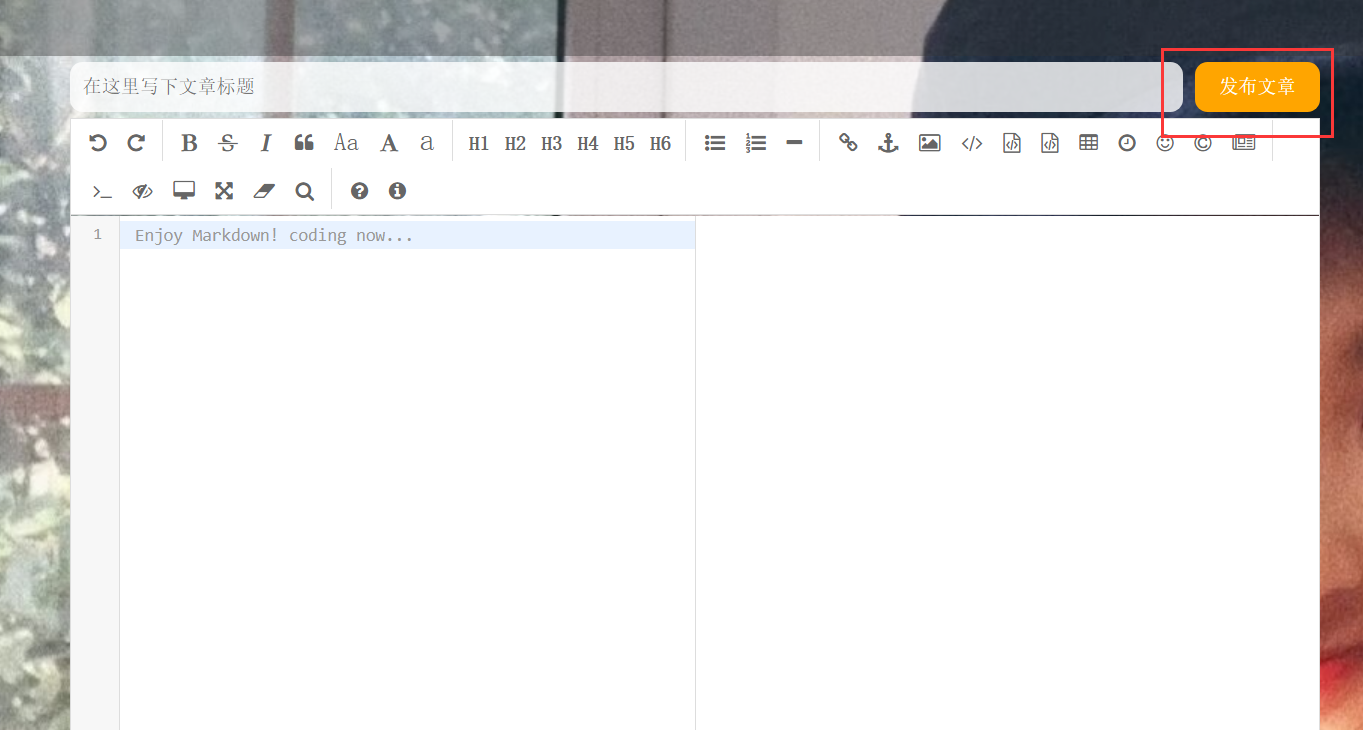
关键操作在于点击"发布文章" , 前端将标题和正文返回给后端 , 后端将该篇文章存储到数据库中 .
前端代码 :
<!DOCTYPE html>
<html lang="en">
<head>
<meta charset="UTF-8">
<meta http-equiv="X-UA-Compatible" content="IE=edge">
<meta name="viewport" content="width=device-width, initial-scale=1.0">
<title>博客编辑</title>
<!-- 引入自己写的样式 -->
<link rel="stylesheet" href="css/conmmon.css">
<link rel="stylesheet" href="css/blog_edit.css">
<!-- 引入 editor.md 的依赖 -->
<link rel="stylesheet" href="editor.md/css/editormd.min.css" />
<script src="js/jquery.min.js"></script>
<script src="editor.md/editormd.js"></script>
</head>
<body>
<!-- 导航栏 -->
<div class="nav">
<img src="img/logo2.jpg" alt="">
<span class="title">博客系统</span>
<!-- 用来占据中间位置 -->
<span class="spacer"></span>
<a href="blog_list.html">主页</a>
<!-- <a href="blog_edit.html">写博客</a> -->
<a href="login.html">登录</a>
<!-- <a href="#">注销</a> -->
</div>
<!-- 编辑框容器 -->
<div class="blog-edit-container">
<!-- 标题编辑区 -->
<div class="title">
<input id="title" type="text" placeholder="在这里写下文章标题">
<button onclick="mysub()">发布文章</button>
</div>
<!-- 创建编辑器标签 -->
<div id="editorDiv">
<textarea id="editor-markdown" style="display:none;"></textarea>
</div>
</div>
<script>
var editor;
function initEdit(md){
// 编辑器设置
editor = editormd("editorDiv", {
// 这里的尺寸必须在这里设置. 设置样式会被 editormd 自动覆盖掉.
width: "100%",
// 高度 100% 意思是和父元素一样高. 要在父元素的基础上去掉标题编辑区的高度
height: "calc(100% - 50px)",
// 编辑器中的初始内容
markdown: md,
// 指定 editor.md 依赖的插件路径
path: "editor.md/lib/",
saveHTMLToTextarea: true //
});
}
initEdit(""); // 初始化编译器的值
// 提交
function mysub(){
var title = jQuery("#title");
var content = editor.getValue();
// 非空效验
if(title.val()==""){
title.focus();
alert("请先输入标题!");
return false;
}
if(content==""){
content.focus();
alert("请先输入正文!");
return false;
}
jQuery.ajax({
url:"/art/edit",
type:"POST",
data:{
"title":title.val(),
"content":content
},
success:function(result){
if(result.code==200 && result.data>0){
alert("恭喜:发布成功!");
location.href = "myblog_list.html";
}else{
alert("抱歉:发布失败,请重试!");
}
},
error:function(err){
if(err!=null && err.status==401){
alert("用户未登录,即将跳转到登录页!");
// 已经被拦截器拦截了,未登录
location.href = "/login.html";
}
}
});
}
</script>
</body>
</html>
后端代码 :
ArticleController
//编辑文章
@RequestMapping("/edit")
public int edit(HttpServletRequest request,String title, String content) {
if (!StringUtils.hasLength(title) || !StringUtils.hasLength(content)) {
return 0;
}
UserInfo userInfo = SessionUtil.getLoginUser(request);
if (userInfo != null && userInfo.getId() > 0) {
return articleService.edit(title, content,userInfo.getId());
}
return 0;
}
ArticleService
//编辑文章
public int edit(String title, String content,Integer uid) {
return articleMapper.edit(title, content,uid);
}
ArticleMapper
//编辑文章
public int edit(@Param("title") String title,
@Param("content") String content,
@Param("uid") Integer uid);
ArticleMapper.xml
<!-- 编辑文章-->
<insert id="edit" >
insert into articleinfo(title,content,uid) values(#{title},#{content},#{uid})
</insert>
4.5.5 主页[分页功能]
点击主页 , 跳转至博客列表主页 , 这个页面包括所有用户的文章 . 同时在该页面中 , 实现了分页功能 , 同一页面只显示2篇文章 . 分页功能的原理如下 :
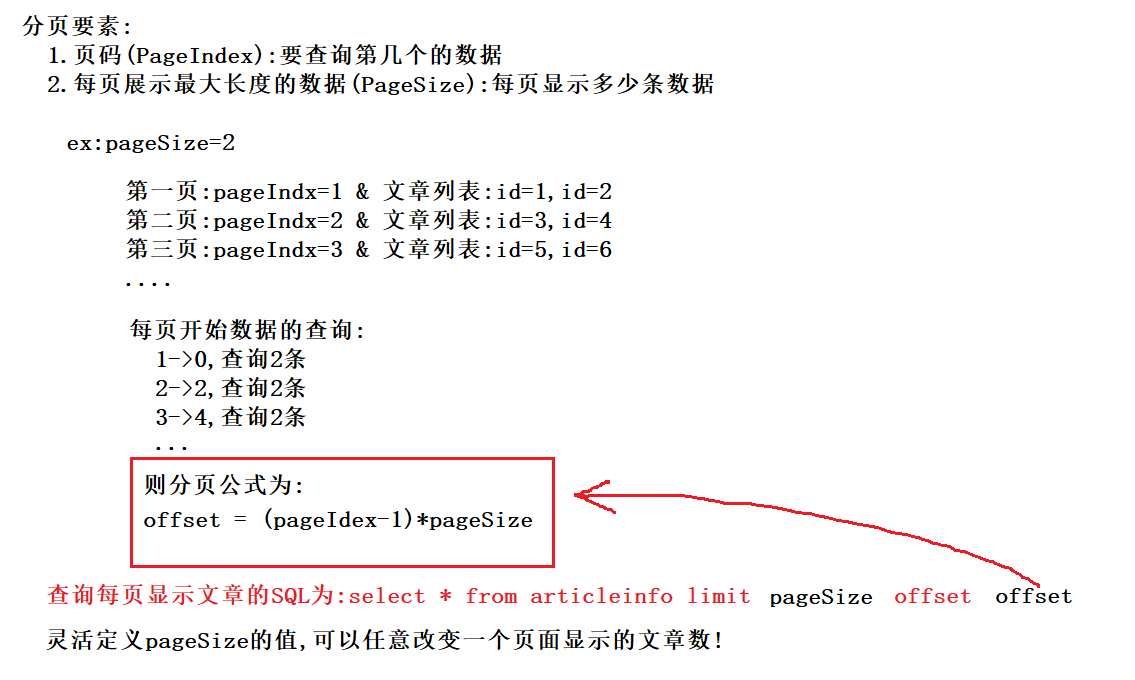
删除原有文章 , 插入5篇测试文章 , 显示查询效果 :
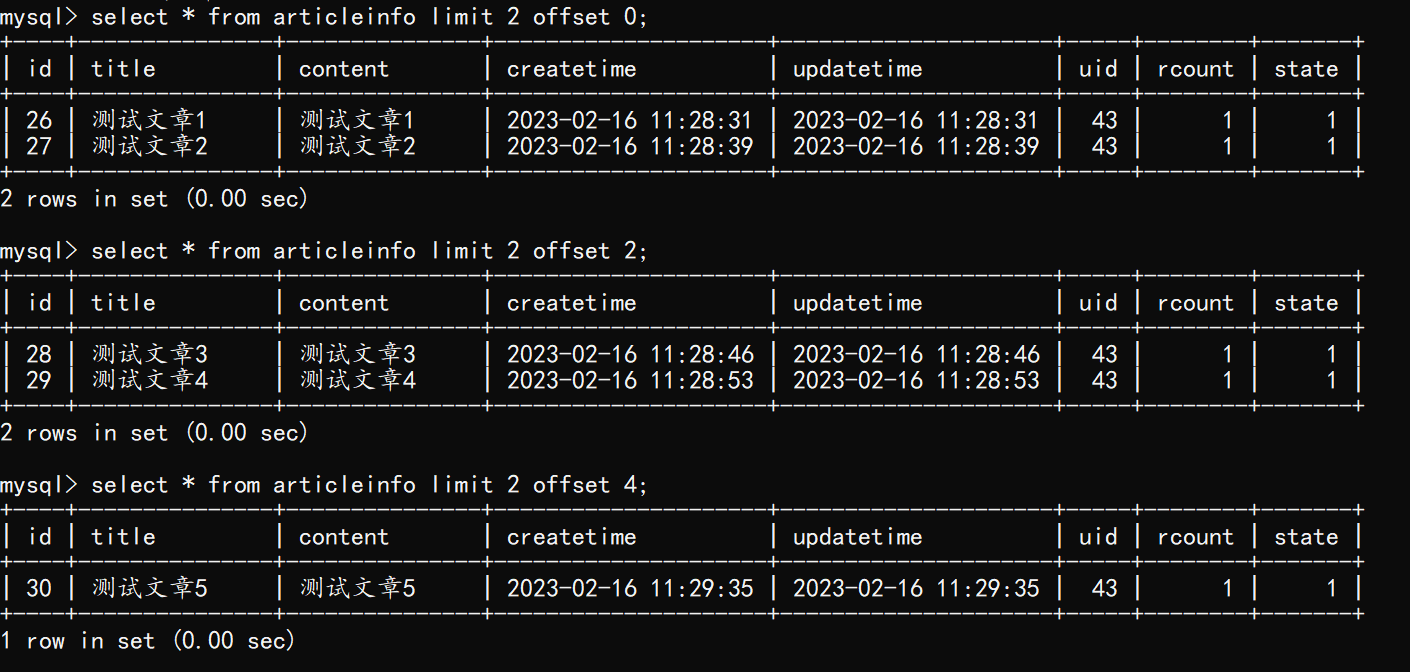
前端代码 :
<!DOCTYPE html>
<html lang="en">
<head>
<meta charset="UTF-8">
<meta http-equiv="X-UA-Compatible" content="IE=edge">
<meta name="viewport" content="width=device-width, initial-scale=1.0">
<title>博客列表</title>
<link rel="stylesheet" href="css/list.css">
<link rel="stylesheet" href="css/blog_list.css">
<link rel="stylesheet" href="css/homepage.css">
<script src="js/jquery.min.js"></script>
<script src="js/tools.js"></script>
</head>
<body>
<!-- 导航栏 -->
<div class="nav">
<img src="img/logo2.jpg" alt="">
<span class="title">博客系统</span>
<!-- 用来占据中间位置 -->
<span class="spacer"></span>
<a href="myblog_list.html">个人中心</a>
<a href="login.html">登录</a>
<a href="reg.html">注册</a>
<a href="javascript:onExit()">注销</a>
</div>
<!-- 版心 -->
<div class="container">
<!-- 右侧内容详情 -->
<div class="container-right" style="width: 100%;">
<div id="listDiv">
</div>
<hr>
<div class="blog-pagnation-wrapper">
<button class="blog-pagnation-item" onclick="firstClick()">首页</button>
<button class="blog-pagnation-item" onclick="beforeClick()">上一页</button>
<button class="blog-pagnation-item" onclick="nextClick()">下一页</button>
<button class="blog-pagnation-item" onclick="lastClick()">末页</button>
</div>
</div>
</div>
<script>
var descLength = 80; // 简介最大长度
// 字符串截取,将文章正文截取成简介
function mySubstr(content){
if(content.length>descLength){
return content.substr(0,descLength);
}
return content;
}
var pindex = 1; // 当前的页码
var psize = 2; // 每页显示的条数信息
var totalpage = 1; // 总共多少页
// 初始化分页的参数,尝试从 url 中获取 pindex 和 psize
function initPageParam(){
var pi = getUrlParam("pindex");
if(pi!=""){
pindex=pi;
}
var pz = getUrlParam("psize");
if(pz!=""){
psize=pz;
}
}
initPageParam();
// 查询总共有多少页的数据
function getTotalPage(){
jQuery.ajax({
url:"/art/totalpage",
type:"GET",
data:{
"psize":psize
},
success:function(result){
if(result.code==200 && result.data!=null){
totalpage=result.data;
}
}
});
}
getTotalPage();
// 查询分页数据
function getList(){
jQuery.ajax({
url:"/art/list",
type:"GET",
data:{
"pindex":pindex,
"psize":psize
},
success:function(result){
if(result.code==200 && result.data!=null && result.data.length>0){
// 循环拼接数据到 document
var finalHtml="";
for(var i=0;i<result.data.length;i++){
var item = result.data[i];
finalHtml+='<div class="blog">';
finalHtml+='<div class="title">'+item.title+'</div>';
finalHtml+='<div class="date">'+item.createtime+'</div>';
finalHtml+='<div class="desc">'+mySubstr(item.content)+'</div>';
finalHtml+='<div style="text-align: center;margin-top: 50px;">';
finalHtml+='<p style="text-align: center">';
finalHtml+='<a id="clickIt" href="blog_content.html?id='+item.id+'">查看全文</a></p></div>';
finalHtml+='</div>';
}
jQuery("#listDiv").html(finalHtml);
}
}
});
}
getList();
// 首页
function firstClick(){
location.href = "blog_list.html";
}
// 上一页
function beforeClick(){
if(pindex<=1){
//alert("当前已是第一页!");
location.reload();
return false;
}
pindex = parseInt(pindex)-1;
location.href = "blog_list.html?pindex="+pindex+"&psize="+psize;
}
// 下一页
function nextClick(){
pindex = parseInt(pindex)+1;
if(pindex>totalpage){
location.reload();
// 已经在最后一页了
//alert("当前已是最后一页!");
return false;
}
location.href = "blog_list.html?pindex="+pindex+"&psize="+psize;
}
// 末页
function lastClick(){
pindex = totalpage;
location.href = "blog_list.html?pindex="+pindex+"&psize="+psize;
}
// 退出登录
function onExit(){
if(confirm("确认退出?")){
// ajax 请求后端进行退出操作
jQuery.ajax({
url:"/user/logout",
type:"POST",
data:{},
success:function(result){
location.href = "/login.html";
},
error:function(err){
if(err!=null && err.status==401){
alert("用户未登录,即将跳转到登录页!");
// 已经被拦截器拦截了,未登录
location.href = "/login.html";
}
}
});
}
}
</script>
</body>
</html>
后端代码 :
ArticleController
//获取总页数
@RequestMapping("/totalpage")
public Integer totalPage(Integer psize) {
if (psize != null) {
// 参数有效
int totalCount = articleService.getTotalCount();
// 总页数
int totalPage = (int) Math.ceil(totalCount * 1.0 / psize);
return totalPage;
}
return null;
}
//获取分页
@RequestMapping("/list")
public List<ArticleInfo> getList(Integer pindex, Integer psize) {
if (pindex == null || psize == null) {
return null;
}
// 分页公式,计算偏移量
int offset = (pindex - 1) * psize;
return articleService.getList(psize, offset);
}
ArticleService
//获取总页数
public int getTotalCount() {
return articleMapper.getTotalCount();
}
//获取分页
public List<ArticleInfo> getList(Integer psize, Integer offset) {
return articleMapper.getList(psize, offset);
}
ArticleMapper
//获取总页数
public int getTotalCount();
//获取分页
public List<ArticleInfo> getList(@Param("psize") Integer psize,
@Param("offset") Integer offset);
ArticleController.xml
<!-- 获取总页数-->
<select id="getTotalCount" resultType="java.lang.Integer">
select count(*) from articleinfo
</select>
<!-- 获取分页-->
<select id="getList" resultType="com.example.demo.model.ArticleInfo">
select * from articleinfo limit #{psize} offset #{offset}
</select>
点击首页 :
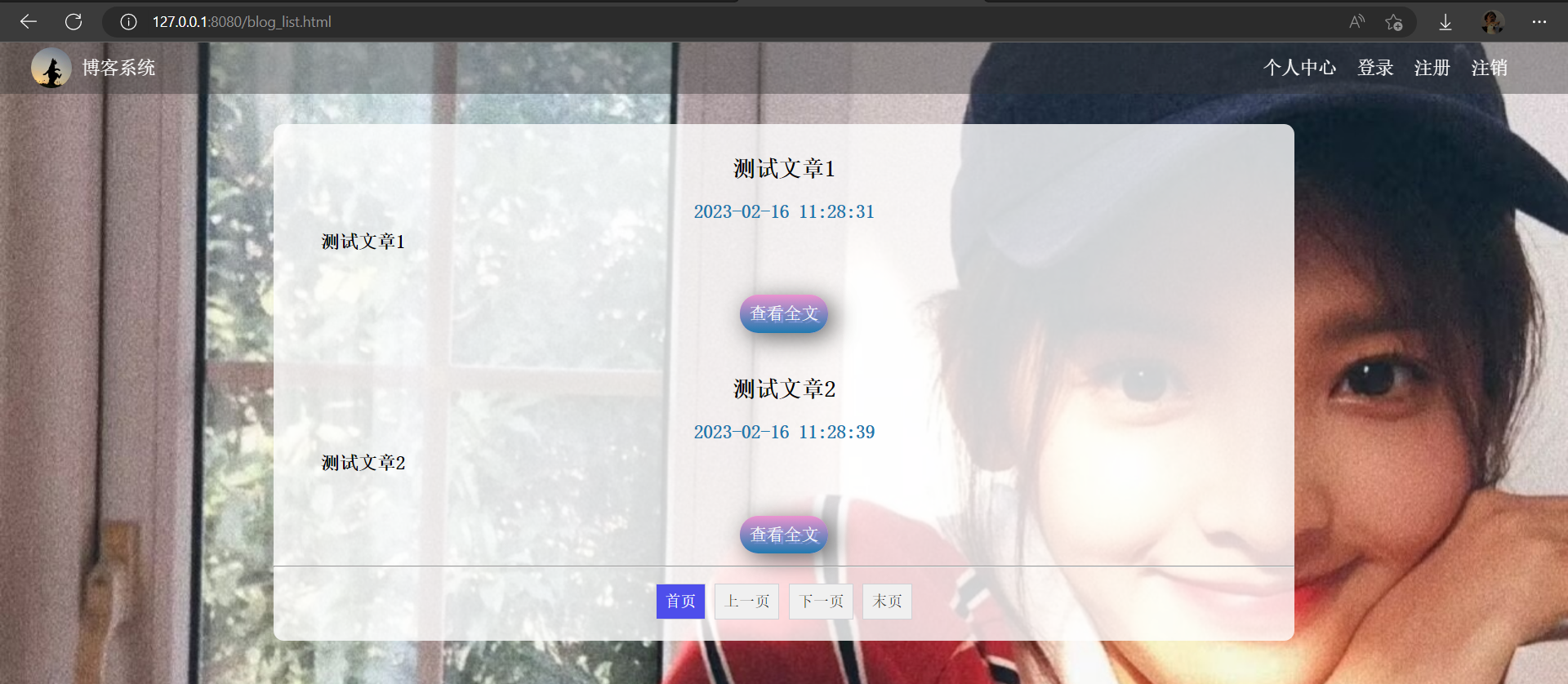
点击下一页 :
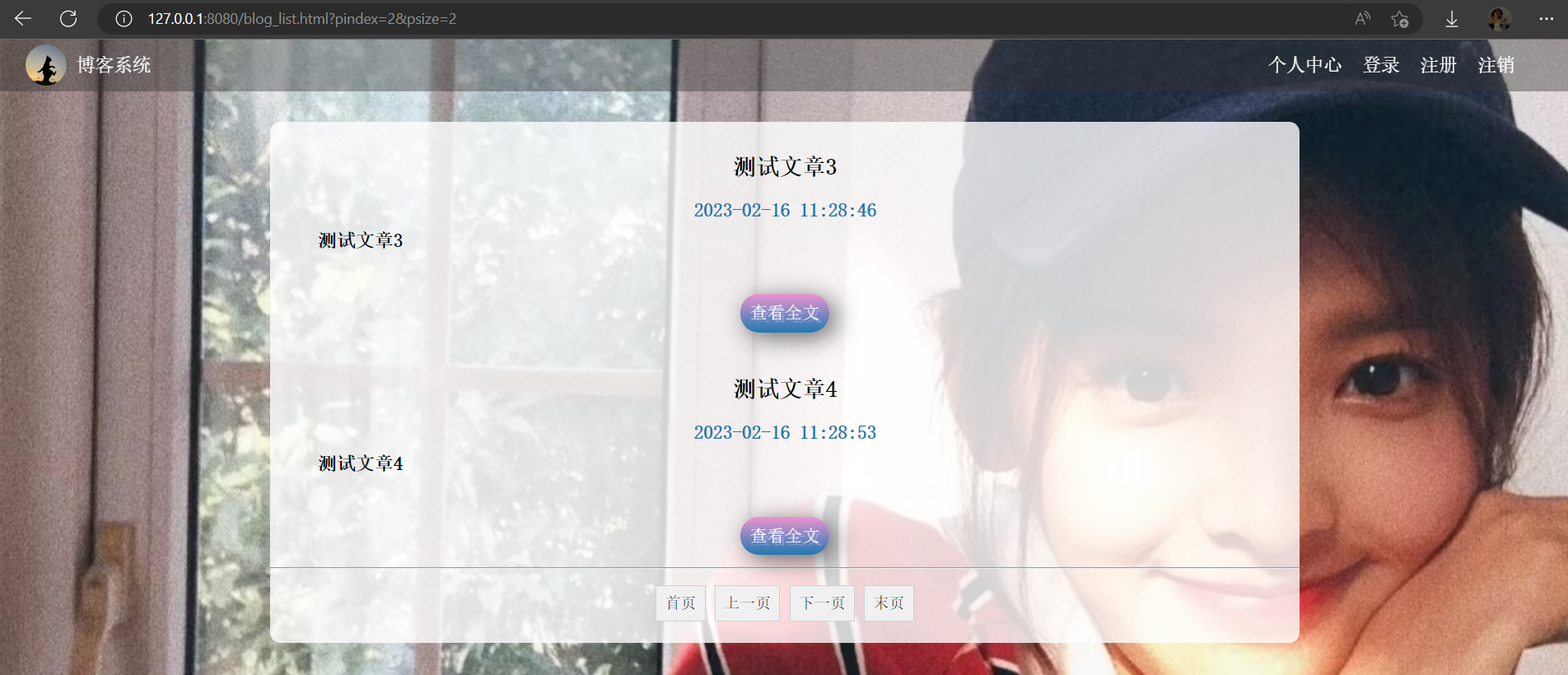
点击末页 :

4.5.6 查看详情
前端代码 :
前端只需发送一个ajax请求 , 携带文章id , 后端在数据库中查询出文章标题和正文 , 返回给前端即可 . 每次查看该篇文章 , 我们需要将访问量 + 1 ,所以还需发送一个ajax请求 , 用于设置访问量 + 1 . 同理 , 在显示所有人文章的主页 , 点击查看全文 , 我们也应该设置访问量 + 1 . 综上所述 , 只要访问blog_content页面 , 就使访问量 + 1 .
//获取文章详细信息
function getArticleDetail() {
if(aid != null && aid > 0) {
//访问后端,更新访问量
jQuery.ajax({
url:"/art/setrcount",
type:"POST",
data:{"aid":aid},
success:function(result) {
}
});
//访问后端查询文章详情
jQuery.ajax({
url:"/art/detail",
type:"POST",
data:{"aid":aid},
success:function(result) {
if(result.code == 200 && result.data != null) {
var art = result.data;
jQuery("#title").text(art.title);
jQuery("#date").text(art.createtime);
jQuery("#rcount").text(art.rcount);
editormd = editormd.markdownToHTML("editorDiv",{
markdown : art.content
});
myInfo(art.uid);
getArticleCount(art.uid);
getTotalRcount(art.uid);//侧边栏访问量信息
}
}
});
}
}
getArticleDetail();
ArticleController
//设置访问量
@RequestMapping("/setrcount")
public int setRcount(Integer aid) {
return articleService.setRcount(aid);
}
//blog_content页面获取文章详情
@RequestMapping("/detail")
public Object getDetail(Integer aid) {
if(aid != null && aid > 0) {
return AjaxResult.success(articleService.getDetail(aid));
}
return AjaxResult.fail(-1,"查询失败");
}
ArticleService
//设置访问量
public int setRcount(Integer aid) {
return articleMapper.setRcount(aid);
}
//获取文章内容
public ArticleInfo getDetail(Integer aid) {
return articleMapper.getDetail(aid);
}
ArticleMapper
//设置访问量
public int setRcount(@Param("aid") Integer aid);
//获取文章内容
public ArticleInfo getDetail(@Param("aid") Integer aid);
ArticleController.xml
<!-- 设置访问量-->
<update id="setRcount">
update articleinfo set rcount=rcount+1 where id=#{aid}
</update>
<!-- 根据文章编号查询文章信息-->
<select id="getDetail" resultType="com.example.demo.model.ArticleInfo">
select * from articleinfo where id=#{aid}
</select>
4.5.7 修改文章
当我们点击修改时 , 首先要显示整篇文章 , 这需要前端向后端请求数据 , 并且通过ajax请求传递当前文章的id . 其次 , 发送一个更新文章的ajax请求 , 这可以完全参考文章编辑页的做法 . 代码如下 :
前端代码 :
<!DOCTYPE html>
<html lang="en">
<head>
<meta charset="UTF-8">
<meta http-equiv="X-UA-Compatible" content="IE=edge">
<meta name="viewport" content="width=device-width, initial-scale=1.0">
<title>博客编辑</title>
<!-- 引入自己写的样式 -->
<link rel="stylesheet" href="css/conmmon.css">
<link rel="stylesheet" href="css/blog_edit.css">
<!-- 引入 editor.md 的依赖 -->
<link rel="stylesheet" href="editor.md/css/editormd.min.css" />
<script src="js/jquery.min.js"></script>
<script src="editor.md/editormd.js"></script>
<script src="js/tools.js"></script>
</head>
<body>
<!-- 导航栏 -->
<div class="nav">
<img src="img/logo2.jpg" alt="">
<span class="title">博客系统</span>
<!-- 用来占据中间位置 -->
<span class="spacer"></span>
<a href="blog_list.html">主页</a>
<a href="blog_edit.html">写博客</a>
<a href="javascript:onExit()">注销</a>
</div>
<!-- 编辑框容器 -->
<div class="blog-edit-container">
<!-- 标题编辑区 -->
<div class="title">
<input id="title" type="text" placeholder="在这里写下文章标题">
<button onclick="mysub()">修改文章</button>
</div>
<!-- 创建编辑器标签 -->
<div id="editorDiv">
<textarea id="editor-markdown" style="display:none;"></textarea>
</div>
</div>
<script>
var editor;
function initEdit(md){
// 编辑器设置
editor = editormd("editorDiv", {
// 这里的尺寸必须在这里设置. 设置样式会被 editormd 自动覆盖掉.
width: "100%",
// 高度 100% 意思是和父元素一样高. 要在父元素的基础上去掉标题编辑区的高度
height: "calc(100% - 50px)",
// 编辑器中的初始内容
markdown: md,
// 指定 editor.md 依赖的插件路径
path: "editor.md/lib/",
saveHTMLToTextarea: true //
});
}
// 提交
function mysub(){
var title = jQuery("#title");
var content = editor.getValue();
// 非空效验
if(title.val()==""){
title.focus();
alert("请先输入标题!");
return false;
}
if(content==""){
title.focus();
alert("请先输入正文!");
return false;
}
jQuery.ajax({
url:"/art/update",
type:"POST",
data:{
"aid":aid,
"title":title.val(),
"content":content
},
success:function(result){
if(result.code==200 && result.data>0){
alert("恭喜:修改成功!");
location.href = "myblog_list.html";
}else{
alert("抱歉:修改失败,请重试!");
}
},
error:function(err){
if(err!=null && err.status==401){
alert("用户未登录,即将跳转到登录页!");
// 已经被拦截器拦截了,未登录
location.href = "/login.html";
}
}
});
}
// 查询文章详情并展现
function showArt(){
// 从 url 中获取文章 id
aid=getUrlParam("id");
if(aid!=null && aid>0){
// 访问后端查询文章详情
jQuery.ajax({
url:"/art/detailbyid",
type:"POST",
data:{"aid":aid},
success:function(result){
if(result.code==200 && result.data!=null){
var art = result.data;
jQuery("#title").val(art.title);
initEdit(art.content);
}else{
alert("查询失败,请重试!");
}
},
error:function(err){
if(err!=null && err.status==401){
alert("用户未登录,即将跳转到登录页!");
// 已经被拦截器拦截了,未登录
location.href = "/login.html";
}
}
});
}
}
showArt();
// 退出登录
function onExit(){
if(confirm("确认退出?")){
// ajax 请求后端进行退出操作
jQuery.ajax({
url:"/user/logout",
type:"POST",
data:{},
success:function(result){
location.href = "/login.html";
},
error:function(err){
if(err!=null && err.status==401){
alert("用户未登录,即将跳转到登录页!");
// 已经被拦截器拦截了,未登录
location.href = "/login.html";
}
}
});
}
}
</script>
</body>
</html>
后端代码 :
ArticleController
//根据文章id查询文章
@RequestMapping("/detailbyid")
public Object getDetilById(HttpServletRequest request, Integer aid) {
if (aid != null && aid > 0) {
// 根据文章查询文章的详情
ArticleInfo articleInfo = articleService.getDetail(aid);
// 文章的归属人验证
UserInfo userInfo = SessionUtil.getLoginUser(request);
if (userInfo != null && articleInfo != null &&
userInfo.getId() == articleInfo.getUid()) { // 文章归属人是正确的
return AjaxResult.success(articleInfo);
}
}
return AjaxResult.fail(-1, "查询失败");
}
//更新文章
@RequestMapping("/update")
public int update(HttpServletRequest request, Integer aid, String title, String content) {
if (!StringUtils.hasLength(title) || !StringUtils.hasLength(content)) {
return 0;
}
UserInfo userInfo = SessionUtil.getLoginUser(request);
if (userInfo != null && userInfo.getId() > 0) {
return articleService.update(aid, userInfo.getId(), title, content);
}
return 0;
}
ArticleService
//更新文章
public int update(Integer aid, Integer uid, String title, String content) {
return articleMapper.update(aid, uid, title, content);
}
ArticleMapper
//更新文章
public int update(@Param("aid") Integer aid,
@Param("uid") Integer uid,
@Param("title") String title,
@Param("content") String content);
ArticleController.xml
<!-- 修改文章-->
<update id="update">
update articleinfo set title=#{title},content=#{content}
where id=#{aid} and uid=#{uid}
</update>
4.5.8 删除文章
删除文章 , 直接将该篇文章从数据库中删除即可 , 前端只需向后端传递表示该篇文章的唯一参数 —> 文章id .
前端代码 :
//删除文章
function myDel(id){
if(confirm("确认要删除该文章吗?")){
jQuery.ajax({
url:"/art/mydel",
type:"POST",
data:{
"id" : id
},
success:function(result) {
if(result.code==200 && result.data!=null) {
alert("删除成功!");
location.href = "myblog_list.html";
}
},
error:function(err){
if(err != null) {
alert("删除失败,请重试!");
}
}
});
}
}
后端代码 :
ArticleController
//删除文章
@RequestMapping("/mydel")
public boolean delete(Integer id) {
if(id == null) {
return false;
}
return articleService.delete(id);
}
ArticleService
//删除文章
public boolean delete(Integer id) {
return articleMapper.delete(id);
}
ArticleMapper
//删除文章
public boolean delete(@Param("id") Integer id);
ArticleController.xml
<!-- 删除文章-->
<delete id="delete">
delete from articleinfo where id=#{id}
</delete>
五 : 密码加盐
存储密码的方式 , 主要有以下几种 :
1.明文 , 显然明文存储是最不安全的 ;
2.MD5加密 , 即MD5消息摘要算法,属Hash算法一类。MD5算法对输入任意长度的消息进行运行,产生一个128位的消息摘要(32位的数字字母混合码)。
MD5主要特点 : 不可逆,相同数据的MD5值肯定一样,不同数据的MD5值不一样 . 那这个时候 , 我如果搞一个对照表 , 就可以进行暴力破解了 , 比如 :
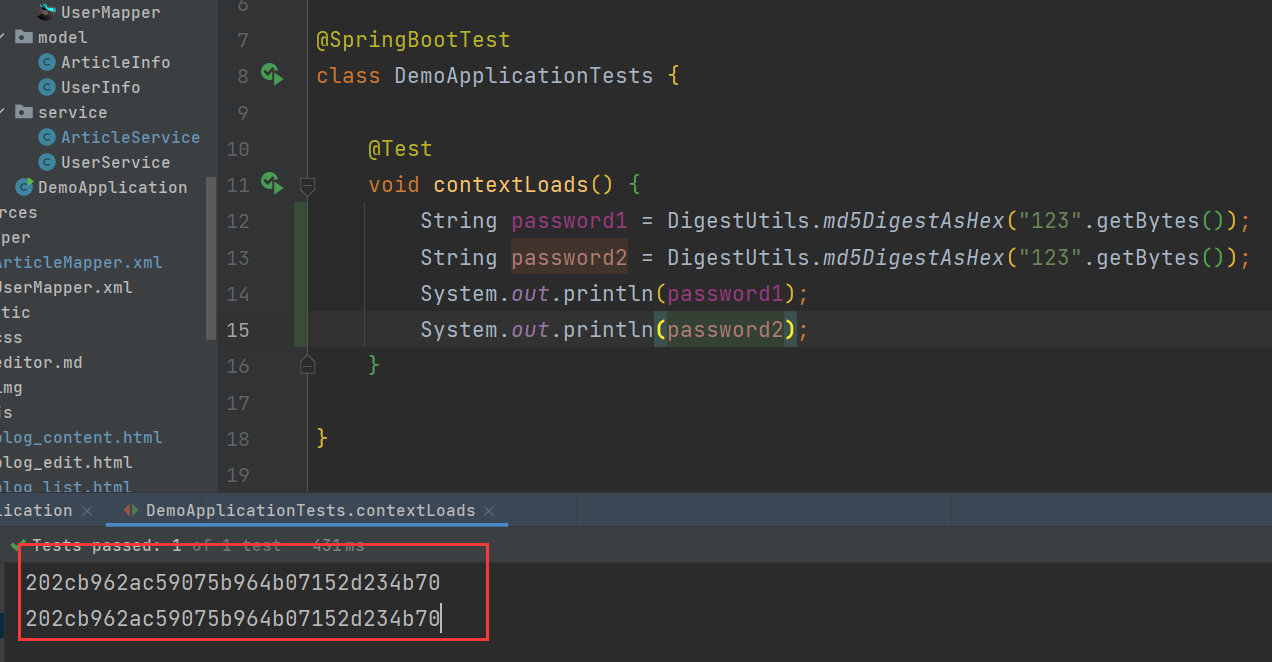
我们对"123"这个字符串加密两次 , 发现加密结果是一致的 . 在任何时间 , 任何地点 , 对"123"字符串的MD5加密都是这个结果 . 那么 , 如果我有一张对照表 , key值是MD5加密结果 , value值是原字符串 , 我就可以通过遍历的方式通过key拿value . 所以MD5仅仅提供了最基础的加密功能 .
3.加盐算法 , 每次在进行加密时 , 给该密码加一个盐值 , 并且每次生成的盐值都不同 .

代码如下 :
package com.example.demo.common;
import org.springframework.util.DigestUtils;
import org.springframework.util.StringUtils;
import java.util.UUID;
/**
* 加盐加密类
*/
public class SecurityUtil {
//加盐加密
public static String encrypt(String password) {
//1.每次生成32位的不同盐值
String salt = UUID.randomUUID().toString().replace("-","");
//2.盐值+密码生成最终的32位密码
String finalPassword = DigestUtils.md5DigestAsHex((salt + password).getBytes());
//3.同时返回盐值+最终密码
return salt + finalPassword;
}
//密码验证
public static boolean decrypt(String password,String databasePassword) {
//1.非空校验
if(!StringUtils.hasLength(password) || !StringUtils.hasLength(databasePassword)) {
return false;
}
//2.验证数据库存储密码是否为64位
if(databasePassword.length() != 64) {
return false;
}
//3.提取盐值
String salt = databasePassword.substring(0,32);
//4.生成待验证密码
String securityPassword = DigestUtils.md5DigestAsHex((salt+password).getBytes());
//5.返回密码验证的结果
return (salt + securityPassword).equals(databasePassword);
}
}
六 : 部署
6.1 建库建表
连接数据库 :
mysql -uroot
建立数据库 :
create database myblog;
建表 :
-- 创建文章表
drop table if exists userinfo;
create table articleinfo(
id int primary key auto_increment,
title varchar(100) not null,
content text not null,
createtime timestamp default now(),
uid int not null,
rcount int not null default 0,
state int default 1
)default charset 'utf8mb4';
-- 创建表[用户表]
drop table if exists userinfo;
create table userinfo(
id int primary key auto_increment,
username varchar(100) not null,
password varchar(64) not null,
photo varchar(500) default '',
createtime timestamp default now(),
`state` int default 1
) default charset 'utf8mb4';
注意 : 此处为简便处理 , 将创建文章时间和更新文章时间合成了一个字段 , 即createtime .
6.2 打包
首先修改配置信息 , linux上数据库密码默认为空 .

设置打包后的包名 :

双击package进行打包 :

将jar包拷贝到云服务器上 ;

6.3 运行
nohup java -jar myblog.jar &
博客系统url : 链接
本文到此结束 !


